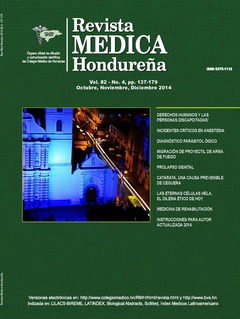Critical incidents in anesthesia: increasing number through voluntary anonymous reporting, University Hospital, Honduras, 2014
Keywords:
Anesthesia, Anesthesiology, Department of Anesthesia,, Hospital, Critical Incident TechniqueAbstract
Background: The critical incidents (CI) are an important cause of perioperative morbidity and mortality. Objective: To describe the characteristics of the IC in anesthesia according to three sources, Operating Room, University College Hospital, Tegucigalpa, Honduras, May-June 2014. Methodology: A cross-sectional study of ASA I-II patients. CI was recorded according to three sources: anonymous Voluntary Communication Questionnaire (VCQ), Anesthesia Form (AF) and Nursing Book (NB). A database was created using EpiInfo Vs.7; with uni-bivariate analysis. Results: In 504 patients undergoing surgery, 40 (7.9%), 20 (4.0%) and 8 (1.6%) CI were recorded according to VCQ, AF and NB, respectively. The person responsible for CI was First-year Resident 40.0% (16) VCQ, Anesthesia Technician 41.6% (4) AF and First-year Resident 50.0% (4) NB. In VCQ, average hours worked before CI 11 hours (1-30 hours) and mean years of experience 3 (0.4-24 years). The CI occurred in the maintenance period 42.5% (17) VCQ, 58.3% (7) AF and 62.5% (5) NB. CI was mild and moderate 15.0% (6) and 75.0% (30) VCQ, 16.6% (2) and 66.6% (8) AF and 25.0% (4) and 50.0% (3) NB, respectively. The identified causes were lack of experience 37.5% (15) VCQ, 33.3% (4) AF and 25.0% (2) NB, no/inappropriate aid 27.5% (11) VCQ, central oxygen failure 7.5% (3) VCQ and 60.0% (4) NB. Discussion: Through voluntary anonymous communication, CI increased 2 to 5 times compared to those reported in AF and NB, respectively. It is recommended the establishment of an adequate registration system for CI and supervision and training for less experienced staff.
Downloads
152




